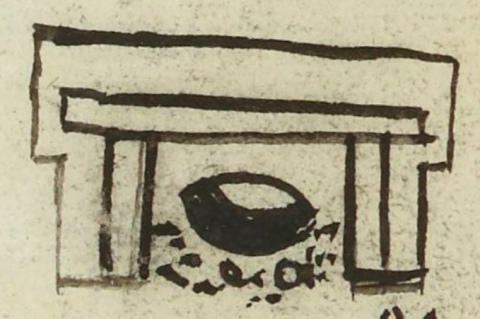Xalpatol (MH730r)
This black-line drawing of the compound glyph for the place name, Xalpatol (“Salvador”), is a Nahuatlization of a Spanish saint’s name. It shows a frontal view of a building, which is a semantic indicator that this is a place name. Inside the building is a large black bean (etl), which is a semantic indicator for the game of patolli, which features beans as playing pieces and provides for the last two syllables of the place name. Patolli was a religious divinatory game. The first syllable, Xal-, is indicated phonetically by the dots of sand (xalli) underneath the bean.
Stephanie Wood
1560
Jeff Haskett-Wood
santos, barrios, pueblos, nombres de lugares, jugar, frijoles, patolli, nombres de lugares, ollas, jarras

xal(li), sand, https://nahuatl.wired-humanities.org/content/xalli
patol(li), a game, https://nahuatl.wired-humanities.org/content/patolli
Salvador (nombre de un lugar en Huejotzingo)
Stephanie Wood
Matrícula de Huexotzinco, folio 730r, World Digital Library, https://www.loc.gov/resource/gdcwdl.wdl_15282/?sp=538&st=image
This manuscript is hosted by the Library of Congress and the World Digital Library; used here with the Creative Commons, “Attribution-NonCommercial-ShareAlike 3.0 License” (CC-BY-NC-SAq 3.0).






